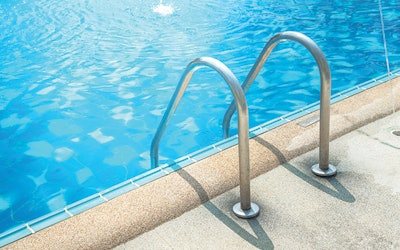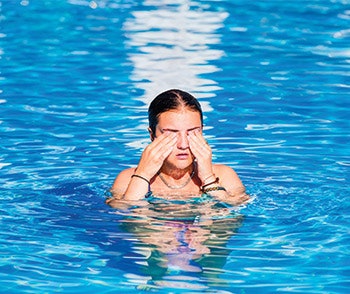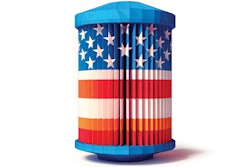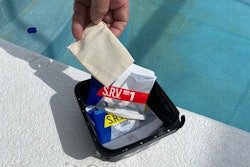
 Chloramines off-gassing at the water's surface can cause bather skin and eye irritation.
Chloramines off-gassing at the water's surface can cause bather skin and eye irritation.
In the pool industry, words get synonymously thrown about and tend to lose their actual meaning. The general term "shock" is often used to cover oxidation, superchlorination, hyperchlorination and breakpoint chlorination, but each refers to specific processes and are used in different situations.
Let's start with oxidation. In order to understand what oxidation is, it helps to determine what it is not. One of the most common misconceptions is that oxidation is the same as disinfection or sanitization.
Disinfection means the killing of virtually all the germs in the pool — 99.999% of them, or what is called a "5-log reduction" of germs.
RELATED: Understanding Advanced Oxidation Process
Sanitization refers to the lowering of the number of germs to an acceptable level. Specifically, it means the killing of 99.9% of germs in the pool, or a "3-log reduction" of germs. It's a subtle but important distinction.
Oxidation is defined in most pool training manuals as a process of removing organic or inorganic contaminants using a chemical that contains oxygen. The term oxidation has to do with the chemical process in which oxygen is used to cause a loss of electrons from molecules, atoms or ions. In swimming pool water this causes the chemical destruction or "burning" of non-living contaminants. It is important to realize that oxidation is not the same as disinfection or sanitization. However, efficient oxidation plays an important role in the process of either disinfecting or sanitizing.
SUPERCHLORINATION
Depending on the application and the amount used, chlorine can act as both a sanitizer and disinfectant. Chlorine can also oxidize as well. The term "superchlorination" has to do with increasing the level of chlorine to sufficiently sanitize a pool, clear hazy water and deal with limited algae growth. When superchlorinating, chlorine is added to raise the measured free chlorine level to 10 to 20 ppm.
Superchlorination is preferred after heavy swimming, a storm or the beginnings of algae. In these cases, superchlorination can help boost oxidation, increase free available chlorine and bring back good water quality. It takes one gallon of a liquid chlorinating 12.5% compound to achieve greater than 10 ppm in 10,000 gallons. Most dry chlorine compounds require more than a pound to achieve 10 ppm in 10,000 gallons. These amounts and levels define what it is to superchlorinate a pool.
HYPERCHLORINATION
There are times when a pool needs to be completely disinfected. Hyperchlorination is used in these situations, in which the chlorine level is raised to 20 to 40 ppm. One such situation would be a case of suspected contamination from a chlorine resistant germ such as cryptosporidium (crypto). This pathogenic protozoan organism can cause illness in swimmers if ingested. Crypto is commonly spread in pools from an accidental fecal release. The Centers for Disease Control (CDC) recommends that hyperchlorination of the pool be done as follows if crypto is suspected in the pool:
1. Pool should be closed
2. An unstabilized form of chlorine such as sodium hypochlorite should be used to raise the water's free chlorine concentration
3. If the CYA level is 15 ppm or greater, then the water must be drained and diluted to reach 1-15 ppm of CYA
4. If the CYA level is between 1-15 ppm the pool can be hyperchlorinated as follows with unstabilized chlorine:
- Raise the free chlorine level to 20 ppm and maintain it for 28 hours or
- Raise the free chlorine level to 30 ppm and maintain it for 18 hours or
- Raise the free chlorine level to 40 ppm and maintain it for 8.5 hours
- Pools with zero CYA raise chlorine level to 20 ppm and maintain it for 12.75 hours.
This CDC-approved hyperchlorination method is designed to inactivate crypto, one of the most chlorine resistant organisms. Based on this recommendation it would not be advised to use chlorine shock products that contain CYA. The CDC has determined that the presence of CYA even at levels of 15 ppm interferes with the percentage of hypochlorous acid HOCl needed to inactivate the crypto germ.
RELATED: Understanding Ammonia and Nitrates
Unstabilized chlorine such as liquid sodium hypochlorite would be best in this scenario. Great care should be taken when hyperchlorinating a pool, and high range test strips may be needed to determine levels of 20 to 40 ppm. Allow chlorine levels to come down or use sodium thiosulfate chlorine reducer to get levels to 4 ppm before allowing swimmers in the pool.
BREAKPOINT CHLORINATION
The technology of using larger amounts of chlorine to help deal with odors and contamination originated in the drinking water industry. The wastewater industry developed a method of breakpoint used primarily for the removal of ammonia. In wastewater technology the breakpoint was achieved at a ratio of 7.6 chlorine to 1 ammonia. Breakpoint is another term that is sometimes used out of context in the pool industry. Breakpoint chlorination is NOT used to clear green pools or deal with crypto. Breakpoint chlorination refers to a method used specifically for the purpose of breaking apart and removing combined chlorine or chloramines. In the pool industry the ratio of chlorine to chloramine is 10 to 1. Once chlorine has completed the hard work of sanitizing and preventing algae, it will combine with other waste material in the pool. It combines and forms two classifications of chloramines which are:
1. Inorganic chloramines — these are molecules made of chlorine combined with:
- Ammonia
- Nitrate
- Nitrite
2. Organic Chloramines – these are molecules made of chlorine combined with:
- Amino acids
- Proteins
- Amines
There can be three types of chloramines that can exist from swimmer waste and environmental contamination. They are as follows:
1. Monochloramine – NH2Cl
One N-H bond is replaced by one N-Cl bond
2. Dichloramine – NHCl2
Two N-H bonds are replaced by two N-Cl bonds
3. Trichloramine – NCl3
All three N-H bonds are replaced by N-Cl bonds
Inorganic forms of chloramines can be readily destroyed via breakpoint using a simple formula to determine the combined chlorine and multiplying based on the results. Breakpoint is achieved more readily if the majority of the combined chloramine is inorganic monochloramine. The formation of chloramines is a result of the reaction of chlorine to everything swimmers bring into the pool and environmental waste in the water.
RELATED: Chloramines in Source Water
Uric acid from sweat and urine are two of the main culprits. When chlorine is added to water with heavy amounts of contaminant, the free chlorine gets consumed quickly and forms combined chlorine, which raises the total chlorine residual. So, while the total chlorine residual may read high, disinfection is actually very low.
Also, as chloramines accumulate and begin to develop into the trichloramine phase they begin to off-gas much more. This leads to very noxious chlorine odors near the surface of the water and creates eye and skin irritation for swimmers. This can be extremely uncomfortable at indoor pools, especially if there is not enough air ventilation. Traditional breakpoint is better used for outdoor pools where the off-gassing of chloramines can be readily removed into the atmosphere. Methods of draining and diluting, proper air handling and superchlorination work better at controlling combined chlorine build up at indoor pools. The addition of ozone or UV oxidation is also a way to control the accumulation of nuisance chloramines at indoor pools.
The formula for determining combined chlorine is as follows:
1. Test total available chlorine TAC and free available chlorine FAC
2. Subtract the FAC reading from the TAC. The resulting number is your combined chlorine CC level
3. Once the CC level is determined, multiply the number times 10
4. Then subtract your FAC reading from the times 10 number to determine how much chlorine in ppm is needed to breakpoint the inorganic chloramines
Example:
TAC = 3 ppm FAC = 1.5 ppm
3 – 1.5 = 1.5 ppm CC
1.5 ppm CC x 10 = 15 ppm
15 ppm – FAC 1.5 ppm = 13.5 ppm
In this case it would take 13.5 ppm of chlorine to accomplish the breakpoint of 1.5 ppm combined chlorine. In a 20,000-gallon pool it would take 2.10 gallons of 12.5% unstabilized liquid sodium hypochlorite to achieve breakpoint for 1.5 ppm combined chlorine. According to ANSI/APSP Standard for Water Quality in Public Pools and Spas the preferable maximum level for combined chlorine is 0.2 ppm. It should be noted again that pools with high levels of CYA would require much more chlorine to achieve breakpoint based on the binding of CYA to HOCl. There are current studies stating that for chlorine to be effective in the presence of CYA there must be a ratio of 20 to 1. Meaning 1 ppm chlorine for every 20 ppm of CYA. The 1.5 ppm of FAC in our example here would be ineffective if the CYA was higher than 30 ppm. The point here is that in the presence of high CYA, chlorine will not be as effective and that includes when using breakpoint. It is because of this that tri-chlor and di-chlor forms of shock should not be used when attempting breakpoint chlorination.
RELATED: Trichlor: The Dependable Pool Performer
As pointed out above, breakpoint is an efficient way to deal with inorganically bound chloramines. However, it is not very effective at removing the organic bound types. Proactive methods of oxidation, such as regular superchlorination using unstabilized chlorine or the addition of ozone and UV, can help prevent formation of the organic bound chloramines. The practice of regular water dilution along with gradual dosing of unstabilized chlorine is another preferred practice for dealing with organic bound chloramines, especially at indoor facilities.
So, the term shocking covers a vast array of scenarios in swimming pools. What is important is to focus on what needs to be achieved when we "shock" the pool.
1. Reasons for Superchlorination:
- Hazy water
- After pool party
- Limited algae growth
- Regular oxidation
- After dilution to prevent organic chloramines
- Sanitization
2. Reasons for Hyperchlorination:
- Heavy algae growth
- Accidental fecal release
- Follow CDC guidelines for crypto
- Disinfection
3. Reasons to Breakpoint:
- Combined chlorine level over 0.2 ppm
- Achieve breaking apart and removal of inorganic chloramines
- Raise the free chlorine level to a majority to achieve sanitizing
Terry Arko has over 40 years of experience in the pool, spa and hot tub industry, working in service, repair, retail sales, chemical manufacturing and product development. He is a CPO instructor through the National Swimming Pool Foundation. He also serves as instructor for the Pool Chemistry Training Institute to certify residential pool techs. Terry is an active member on the Association of Pool and Spa Professionals Recreational Water Quality Committee. He currently works for HASA.








































